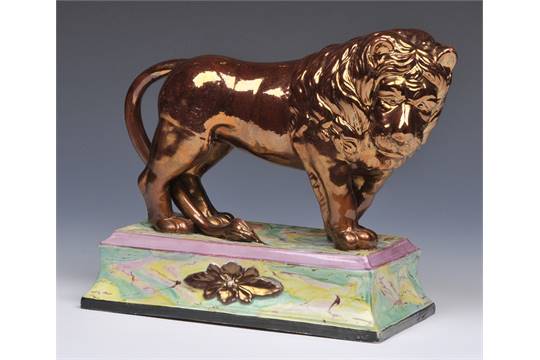Last week, I viewed an auction of a largish collection that included some high ticket pearlware figure groups. The figures were lumped in random lots. Pottery was mixed with porcelain, not-very-old figures were mixed in with early ones, and pairs were split across lots. For some reason, one little figure of not very much value had a lot to itself. Ahead of the auction, this single item had several bids--whereas the desirable lots had none yet. Who wants to buy three expensive figures just to get the one they want? Who has the money to buy two expensive lots to make up a pair? I fear that all these lovely items may not get the respect (and price) they deserve at auction.
This week, a pearlware figure of the lion Nero is coming up at auction in the UK. Incorrectly described as "circa 1900," it has a pre-sale estimate of £50-100. This illustrious beast once stood in the stock of John Howard. It certainly was not made circa 1900--more likely it was made circa 1825-1830. A low pre-sale estimate doesn't necessarily translate into a low final price, but couple it with "circa 1900" and you just never know. Again, seller beware!
Figures of Nero and Wallace were made to pair. In Staffordshire Figures 1780-1840, Volume 3, you can see models of each, titled, and with bocages. I have seen a few single example of these bocage lions, but I have not yet seen a bocage pair. In my collection, I do have a pair with the most fantastic faces--but sadly their bocages are lost.
How do we know that the lustre lion coming up at auction is probably intended to be Nero? We reach this conclusion because of this lion, which appears to be from the same molds.
What happened to Wallace and Nero on that steamy July night when they had to fight for their lives against six of England's fiercest fighting dogs? Nero, who was as tame as a kitten, was reduced to submission in minutes. Wallace, however, was a mean-spirited beast and he quickly finished off his aggressors without suffering a scratch. The story is told in People, Passions, Pastimes, and Pleasures. Please don't tell me that you can't bear to look at figures that touch on the subject of baiting. To turn your head pretending that we are now so very different is to deny man's very nature. Legislation and societal pressure may have put a lid on man's basic impulses, but beneath our civilized veneer, we collectively are, sadly, unchanged.
















